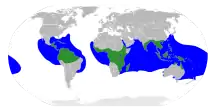Rhizophoraceae
The Rhizophoraceae are a family of tropical or subtropical flowering plants. Among the better-known members are mangrove trees of the genus Rhizophora. Around 147 species are distributed in 15 genera,[1] most native to the Old World.[2] Some species produce wood, used for underwater construction or piling, and tannins for leather making.
| Rhizophoraceae | |
|---|---|
 | |
| Young Rhizophora mangle, a mangrove | |
| Scientific classification | |
| Kingdom: | Plantae |
| Clade: | Tracheophytes |
| Clade: | Angiosperms |
| Clade: | Eudicots |
| Clade: | Rosids |
| Order: | Malpighiales |
| Family: | Rhizophoraceae R.Br. in Flinders |
| Genera | |
 | |
The range of Rhizophoraceae
| |
Description
These are woody plants with opposite or whorled leaves (but not decussate), with insect-pollinated flowers having a nectary disc and typically five petals. This family is now placed in the order Malpighiales, though under the Cronquist system, they formed an order in themselves (Rhizophorales).
These species are often hermaphrodites, more rarely polygamomonoecious. Mangrove species are usually viviparous while those living on land are not.
Genera
Family Rhizophoraceae consists of these genera:[3]
- Anopyxis
- Anstrutheria
- Baraultia
- Blepharistemma
- Bruguiera
- Bruguieria
- Carallia
- Cassipourea
- Ceriops
- Comiphyton
- Crossostylis
- Gynotroches
- Haplopetalon
- Kandelia
- Kanilia
- Karekandelia
- Legnotis
- Macarisia
- Paradrypetes
- Pellacalyx
- Plaesiantha
- Rhizophora
- Richaeia
- Sagittipetalum
- Sterigmapetalum
- Tomostylis
- Weihea
Uses
Apart from the ecosystem services provided by mangroves and the many native uses in food and medicine, several species are valuable sources of timber. This is particularly true of the mangrove species, whose wood, hard and dense but not very durable, is used mainly for underwater pilings, charcoal production and wood-fuel. Mangrove bark is also widely used in the preparation of leather in the tanning industry.[4]
References
- Christenhusz, M. J. M. & Byng, J. W. (2016). "The number of known plants species in the world and its annual increase". Phytotaxa. Magnolia Press. 261 (3): 201–217. doi:10.11646/phytotaxa.261.3.1.
- Stephens, P.F. (2001 onwards). Angiosperm Phylogeny Website. Version 9, June 2008. http://www.mobot.org/MOBOT/Research/APweb/
- "Rhizophoraceae — The Plant List". Theplantlist.org. Retrieved 2019-01-15.
- Flowering Plants of the World by consultant editor Vernon H. Heywood, 1978, Oxford University Press, Walton Street, Oxford OX2 6DP, England, ISBN 019217674-9
External links
 Media related to Rhizophoraceae at Wikimedia Commons
Media related to Rhizophoraceae at Wikimedia Commons